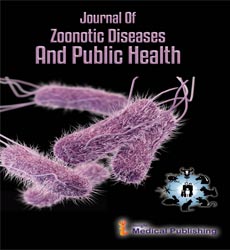Prevention Measures of Zoonotic Diseases for Pathogen that cause Black Death
Ali Montazeri*
Department of Public Health, Pharmacology and Toxicology, University of Nairobi, Kenya
- *Corresponding Author:
- Ali Montazeri
Department of Public Health,
Pharmacology and Toxicology,
University of Nairobi,
Kenya,
E-mail: Montazeri.ali@acerv.ir
Received Date: July 05, 2021 Accepted Date: July 19, 2021 Published Date: July 26, 2021
Citation: Montazeri A (2021) Prevention Measures of Zoonotic Diseases for Pathogen that cause Black Death . J Zoonotic Dis Public Health Vol.5 No.4:e001.
Description
During a large portion of human ancient times, gatherings of tracker finders were presumably tiny. Such gatherings are most likely connected with other such groups just infrequently. Such isolation would have made plague diseases be restricted to some arbitrary close by people since inducing and augmentation of epidemics depend upon unremitting contact with other people who have not yet cultivated an acceptable safe response. To endure in such a populace, a microbe either must be ongoing contamination, remaining present and possibly irresistible in the tainted host for significant stretches, or it needed to have other extra species as supply where it can keep up with itself until additional powerless hosts are reached and contaminated. Indeed, for some 'human' infections, the human is, in reality, better saw as an inadvertent or coincidental casualty and an impasse have. Models incorporate rabies, Bacillus anthracis, tularemia, and West Nile infection. Subsequently, quite a bit of human openness to irresistible sickness has been zoonotic.
Zoonoses are of interest since they are regularly beforehand unnoticed illnesses or have expanded destructiveness in populaces lacking insusceptibility. The West Nile infection showed up in the United States in 1999 in the New York City region, and traveled through the country in the late spring of 2002, causing a lot of misery. Bubonic plague is a zoonotic illness, as are salmonellosis, Rocky Mountain spotted fever and Lyme infection.
Also, lately avian flu and West Nile infection have poured out over into human populaces likely because of associations between the transporter host and homegrown creatures.
Profoundly versatile creatures, for example, bats and birds might introduce a more serious danger of zoonotic transmission than different creatures because of the straightforwardness with which they can move into spaces of human residence. Since they rely upon the human host for a piece of their life-cycle, infections like African schistosomiasis, stream visual deficiency, and elephantiasis are not characterized as zoonotic, despite the fact that they might rely upon transmission by bugs or different vectors.
A central point adding to the presence of new zoonotic microorganisms in human populaces is expanded contact among people and untamed life. This can be caused either by the encroachment of human activity into wilderness areas or by the movement of wild animals into areas of human activity. An illustration of this is the episode of the Nipah infection in peninsular Malaysia in 1999 when serious pig cultivating started in the environment of contaminated natural product bats. Unidentified contamination of the pigs intensified the power of disease, ultimately sending the infection to ranchers and causing 105 human passings.
Numerous advanced sicknesses even plague infections, begun as zoonotic illnesses. It is difficult to build up with conviction which infections hopped from different creatures to people, yet there is expanding proof from DNA and RNA sequencing, that measles, smallpox, flu, HIV, and diphtheria came to people thusly. Different types of normal cold and tuberculosis additionally are variations of strains starting in different species. A few specialists have recommended that all human viral diseases were initially zoonotic.
Open Access Journals
- Aquaculture & Veterinary Science
- Chemistry & Chemical Sciences
- Clinical Sciences
- Engineering
- General Science
- Genetics & Molecular Biology
- Health Care & Nursing
- Immunology & Microbiology
- Materials Science
- Mathematics & Physics
- Medical Sciences
- Neurology & Psychiatry
- Oncology & Cancer Science
- Pharmaceutical Sciences
